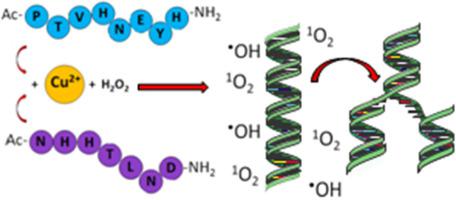Journal of Inorganic Biochemistry ( IF 3.9 ) Pub Date : 2020-09-06 , DOI: 10.1016/j.jinorgbio.2020.111250 Monika Katarzyna Lesiów 1 , Alina Bieńko 1 , Kamila Sobańska 2 , Teresa Kowalik-Jankowska 1 , Krzysztof Rolka 3 , Anna Łęgowska 3 , Natalia Ptaszyńska 3

|
Mono- and dinuclear Cu(II) complexes with Ac-PTVHNEYH-NH2 (L1) and Ac-NHHTLND-NH2 (L2) peptides from FomA protein of Fusobacterium nucleatum were studied by potentiometry, spectroscopic methods (UV–Vis, CD, EPR) and MS technique. The dominant mononuclear complexes for L1 ligand are: CuHL (pH range 5.0–6.0) with 2N {2Nim}, CuH-2L (pH range 8.0–8.5) and CuH-3L species (above pH 9.0) with 4N {Nim, 3N−} coordination modes. The complexes: CuH-1L with 3N {2Nim, N−}, CuH-2L with 3N {Nim, 2N−} and CuH-3L with 4N {Nim, 3N−} binding sites are proposed for the L2 ligand. Probably in the CuH-2L complex for CuL2 system the second His residue in His-His sequence is bound to Cu(II) ion, while the first His residue may stabilize this complex by His-His and/or His-Cu(II) interactions. The dominant dinuclear Cu2L1 complexes in the pH range 6.5–10.5 are: the Cu2H-4L and Cu2H-6L species with 3N{Nim, 2N−}4N{Nim, 3N−} and 4N{Nim, 3N−}4N{Nim, 3N−} binding sites, respectively. In the case of the Cu2L2 complex in the pH range 7.2–10.5, the Cu2H-4L and Cu2H-7L species dominate with 2N{Nim, N−}4N{Nim, 3N−} and (Cu(OH)42−4N{Nim, 3N−}) coordination modes, respectively. The ability to generate reactive oxygen species (ROS) by uncomplexed Cu(II) ions, ligands and their complexes at pH 7.4 in the presence of hydrogen peroxide or ascorbic acid was studied. UV–Vis, luminescence, EPR spin trapping and gel electrophoresis methods were used. Both complexes produce higher level of ROS compared to those of their ligands. ROS produced by Cu(II) complexes are hydroxyl radical and singlet oxygen, which contribute to oxidative DNA cleavage.
中文翻译:

Cu(II) 与来自含有 -His-Xaa-Yaa-Zaa-His 和 -His-His-基序的 FomA 蛋白的肽形成复合物。ROS 生成和 DNA 降解。
单-和双核铜(II)用Ac-PTV络合物ħ NEY ħ -NH 2(L1)和AC-N HH TLND-NH 2(L2)从FOMA蛋白肽具核梭杆菌通过电位进行了研究,光谱法(UV –Vis、CD、EPR)和 MS 技术。L1配体的主要单核配合物是:CuHL(pH 范围 5.0-6.0)与 2N {2N im }、CuH -2 L(pH 范围 8.0-8.5)和 CuH -3 L 物质(pH 9.0 以上)与 4N {N im , 3N − } 协调模式。配合物:CuH -1 L 与 3N {2Nim , N - }, CuH -2 L 与 3N {N im , 2N - } 和 CuH -3 L 与 4N {N im , 3N - } 结合位点被提议用于L2配体。可能在CuL2系统的 CuH -2 L 复合物中,His-His 序列中的第二个 His 残基与 Cu(II) 离子结合,而第一个 His 残基可能通过 His-His 和/或 His-Cu(II) 稳定该复合物) 互动。在 pH 值范围 6.5-10.5 中占主导地位的双核Cu 2 L1配合物是:Cu 2 H -4 L 和 Cu 2 H -6L 个物种分别具有 3N{N im , 2N − }4N{N im , 3N − } 和 4N{N im , 3N − }4N{N im , 3N − } 结合位点。在pH 值范围为 7.2-10.5的Cu 2 L2复合物的情况下,Cu 2 H -4 L 和 Cu 2 H -7 L 物种以 2N{N im , N − }4N {N im , 3N − } 为主和 (Cu(OH) 4 2− 4N{N im , 3N -}) 协调模式,分别。研究了在过氧化氢或抗坏血酸存在下,在 pH 7.4 下未络合的 Cu(II) 离子、配体及其配合物产生活性氧 (ROS) 的能力。使用紫外-可见光、发光、EPR 自旋捕获和凝胶电泳方法。与它们的配体相比,这两种复合物都能产生更高水平的 ROS。Cu(II) 复合物产生的 ROS 是羟基自由基和单线态氧,它们有助于氧化性 DNA 切割。


























 京公网安备 11010802027423号
京公网安备 11010802027423号